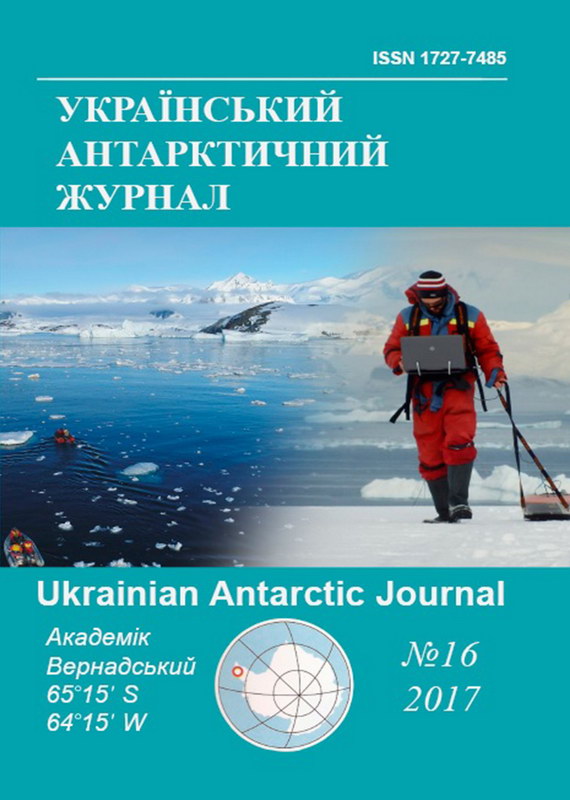Імітаційне моделювання обтікання станції «Академік Вернадський» повітряними потоками для ідентифікації багатоосередкового пошкодження
- імітаційне моделювання,
- CAE,
- CAD,
- багатоосередкове пошкодження,
- станція «Академік Вернадський»
- ANSYS ...Більше

Ця робота ліцензується відповідно до Creative Commons Attribution-NonCommercial-NoDerivatives 4.0 International License.
Анотація
Актуальність роботи полягає в тому, що наслідками передчасного руйнування паливного бака або стіни будівлі Української антарктичної станції «Академік Вернадський» внаслідок багатоосередкового пошкодження можуть бути значні фінансові витрати і людські життя. Тому метою роботи є виявлення найбільш ймовірних місць скупчення снігу та зон максимального тиску вітру для ідентифікації та запобігання багатоосередкового пошкодження будівель та інженерних конструкцій. В якості методів дослідження обрані геометричне і імітаційне моделювання, які дозволяють відповідно створювати і досліджувати тривимірну комп’ютерну модель об’єкта. Для геометричного моделювання була обрана CAD-система SolidWorks. Імітаційне моделювання проходило в програмному комплексі скінчено-елементного аналізу ANSYS. Результати: проведено геометричне і імітаційне моделювання Української антарктичної станції «Академік Вернадський»; в CAD-системі SolidWorks на основі план-схеми і фотографій станції побудована її геометрична модель, яка включає і модель навколишньої місцевості; 3D-принтері роздруковано макет станції по її геометричним моделям; в CAE-системі ANSYS проведено імітаційне моделювання впливу повітряного потоку зі швидкістю 45м/с на станцію; побудовано векторні поля швидкості, на основі яких визначено найбільш ймовірні місця скупчення снігу; побудовано векторні поля тиску, на основі яких визначено найбільш навантажені елементи інфраструктури. Висновки: аналіз результатів моделювання показав, що найбільш ймовірні місця скупчення снігу знаходяться біля стін всіх будівель станції і в місцях значної зміни рельєфу навколишньої місцевості, а найбільш навантаженими від тиску вітру є головний корпус і резервуар для зберігання дизельного палива. У зв’язку з цим було прийнято рішення додатково створити геометричні моделі резервуара для дослідження впливу на його цілісність багатоосередкового пошкодження у вигляді тріщин. Також визначено, що найбільший вплив на елементи інфраструктури станції має вітер з материка, а не з океану.
Посилання
- Antarctic Bases and Buildings - 4. A Modern Energy Efficient Building on Bedrock. URL: https://www.coolantarctica.com/Bases/modern_antarctic_bases4.php (accessed on: December 19, 2017).
- ANSYS. URL: https://www.ansys.com (accessed on: December 19, 2017).
- Halley VI Research Station by Hugh Broughton Architects. URL: http://materialicious.com/2013/02/halley-vi-research-station-by-hugh-broughton-architects.html (accessed on: December 19, 2017).
- Hutton, D. 2008. Fundamentals of finite element analysis. New York, USA: McGraw-Hill Higher Education.
- Komenchuk, I., 2017. Simulation of airflow at the Vernadsky station. In VIII International Antarctic conference dedicated to the 25th anniversary of Ukraine's accession to the Antarctic Treaty. Kyiv, Ukraine, May 16-18, 2017, 176-178.
- Lukyanchenko, O., Vorona, Yu., Kostina, O., Kuzko, O., Kyrychuk, O. 2015. Impact assessment of metal corrosion on fuel reservoir carrying capacity. Ukrainian Antarctic Journal, 14, 246-255.
- Lukyanchenko, O., Vorona, Yu., Kuzko, O. 2015. Evaluation of metal corrosion impact on load bearing capacity of the fuel reservoir. In VII International Antarctic conference. Kyiv, Ukraine, May 12-14, 2015, 101-102.
- Neumayer Station III, Antarctica. URL: https://www.surge-arrester.com/neumayer-station-iii-antarctica (accessed on: December 19, 2017).
- Panoramic view of Jang Bogo Antarctic Research Station 3. URL: http://www.mof.go.kr/jfile/view.do?file-Id=MOF_ARTICLE_6102&fileSeq=1 (accessed on: December 19, 2017).
- Pustovoit, A., Tsybulnik, S. 2017. Modeling of destructive processes in fuel tank. In VIII International Antarctic conference dedicated to the 25th anniversary of Ukraine's accession to the Antarctic Treaty. Kyiv, Ukraine, May 16-18, 2017, 188-190.
- SolidWorks. URL: https://www.solidworks.com (accessed on: December 19, 2017).
- Taishan station construction completed. URL: http://english.cntv.cn/program/china24/20140208/ 104928.shtml (accessed on: December 19, 2017).
- Tsybulnyk, S., Komenchuk, I. 2017. Simulation of Antarctic Vernadsky station. Journal of Engineering Academy of Ukraine, 1, 26-30.
- Zshukovsky, Y., Kuzko, O. 2015. Threats and risks during operation of steel reservoirs with diesel fuel in antarctic conditions. In VII International Antarctic conference. Kyiv, Ukraine, May 12-14, 2015, 97-98.

